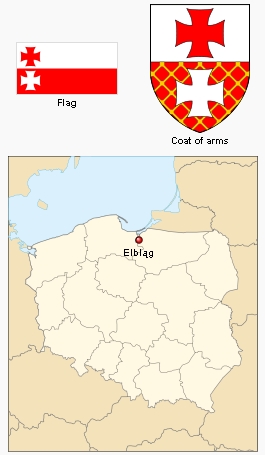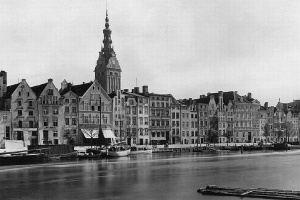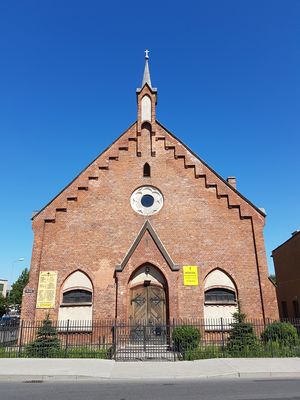Elbing (Warmian-Masurian Voivodeship, Poland)
Introduction
Elbing (also known as Olbiąg; now Elbląg; coordinates: 54.166667, 19.4 [54° 9′ 40″ N 19° 24′ 15″ E]), is a city in what was formerly West Prussia (population in 1875, 33,520; in 1900, 52,518; in 1925, 67,878; in 1939, 83,190; in 2005, 125,000) and what is now Warmian-Masurian Voivodeship, Poland. The city is a port located on the river Elbląg connecting Lake Drużno to the Vistula Lagoon (Zalew Wiślany in Polish, Frisches Haff in German, now known as Vistula Bay), about 10 kilometers from the lagoon and 60 km. from Gdańsk (Danzig).
During the Middle Ages, the Old Prussian settlement of Truso was located at Lake Drużno near the current site of Elbląg in historical Pogesania; the settlement burned down in the 10th century. In 1237, the Teutonic Knights, on behalf of the Roman Catholic Church, conquered the region and the native pagan Old Prussian inhabitants were dispersed in the process. The Teutonic Order built a castle and founded Elbing at the lake with a population mostly from Lübeck. In 1246 the town was granted a constitution under Lübeck Law, providing for self-government as a free city. The city flourished when the Hanseatic League was formed in 1358.
A number of Prussian towns, including Elbing, formed the Prussian Confederation in 1440 and eventually revolted against the Teutonic Knights in 1454. After the defeat of the Teutonic Knights and the destruction of the castle by the inhabitants, the city became part of the autonomous province of Royal Prussia under the suzerainty of the Polish crown in 1466. The city was granted a large measure of self-government and was free to manage its own affairs. Elbing came under the direct control of the Polish crown with the creation of the Polish-Lithuanian Commonwealth in 1569.
Trade with England flourished in the late 16th and early 17th centuries, and the influx of English and Scottish merchants helped to establish the Reformed faith amidst the majority Lutheran Church. Economic prosperity and religious toleration became hallmarks of the city at this time. The Thirty Years War (1618-1648) dealt a severe blow to the economic growth of the city along with the Polish-Swedish wars between 1563 and 1721, and Elbing never fully recovered.
During the First Partition of Poland in 1772, the city state was annexed by King Frederick the Great of the Kingdom of Prussia. Elbing became part of the new Prussian Province of West Prussia in 1773. Elbing became part of the German Empire in 1871 during the unification of Germany and remained a part of Germany by being located in the province of East Prussia following World War I, unlike Danzig and the Marienburger Werder, which became part of the Danzig Free State. Elbing suffered almost total destruction near the end of World War II. In 1945, near the end of the war, most of the German population, including Mennonites, were expelled from the city and Elbing was repopulated with Poles who had been expelled from Polish areas annexed by the Soviet Union as well as Polish peasants from central Poland. The city was ceded by the Soviets to Poland in spring 1945 and then became known as Elbląg.
Mennonite Settlement in Elbing
Elbing was until after World War I the seat of two Mennonite congregations. As early as 1531 Anabaptists are said to have lived in Elbing, and since about the middle of the 16th century Mennonites had lived in Elbing and vicinity. The city had suffered so severely in the war between Poland and Prussia (1519-1521) that the government made serious efforts to attract capable colonists. They gladly accepted the Mennonite refugees fleeing religious persecution in Holland, and gave them charge of managing the farms in the vicinity. In the city proper they were at first not tolerated. In 1550 the council announced to the Mennonites a royal decree that they must leave the city within two weeks. But the expulsion was not rigorously carried out. Nor was the order of expulsion issued by the Polish King Sigismund in 1556 taken very seriously by the city authorities. Their services seem to have been especially required to clear the land in the Ellerwald, which was apportioned to the ruling families of the city in 1565. In 1571 Sebastian Neogeorgius, the pastor of St. Mary's, declaimed against tolerating them on the Ellerwald estates and induced the council to issue an order that the "foreigners" were to leave the region of the city by Easter of 1572. The terminus was extended to autumn, "until the Mennonites have harvested their grain," and then again to 6 January 1575; then the order was completely forgotten (Mannhardt, Wehrfreiheit, 71). The Mennonites stayed on the country estates and are said even to have won Lutheran fellow citizens to their faith.
Soon after this they began to settle in the city of Elbing again. In 1585 Jost van Kampen and Hans van Keulen (Hans von Kőln) were granted citizenship and the permission to engage in the silk trade, which had not yet been introduced into the city (Mannhardt, Danzig, 49), and in 1610 several other Mennonites were accepted as citizens; by 1612 there were 16 Mennonite families living in the city. Difficulties were placed in the way of their residence in the city by the decree of Sigismund III in 1653 requiring the oath of citizenship. But they continued to be tolerated and were not molested by any demands running counter to their conscience. In giving the oath of citizenship with "yea" and "nay," they were required to place the hand on the breast; for freedom from military service they paid a special tax—the regulations of 1660 required one Polish guilder (Carstenn, p. 35), whether they were natives or foreigners, and only in a few insignificant matters in trade and commerce did the council give the Lutherans any advantage (Mannhardt, Danzig, 72).
As it appeared in 2005.
Photo by Victor Wiebe.
In the meantime a Mennonite congregation had formed in Elbing. On 25 August 1586, Jost van Kampen purchased a town house in the Stare Miasto area, Kurze Hinterstrasse 8, later Wilhelmsstrasse. The town house served as a church beginning from 1590 until 1900, when a new, larger building was erected on Berlinerstrasse 20, which was used by the Elbing-Ellerwald congregation until 1945. This congregation had a second church in Ellerwald, a village near Elbing, which was dedicated by Elder Gerhard Wiebe on 5 October 1783, together with a school which was opened by permission of the king of Prussia (Naamlijst 1787, 63). The city and country groups have from the beginning formed the single congregation of Elbing-Ellerwald, with a jointly chosen elder, preachers, and deacons. This is demonstrable back as far as 1606. An old record says, "In 1606 Henrich von dem Bosche served the union in Elbing." In 1610 the council complained to Sigismund III that "the Mennonites among themselves, without the foreknowledge of the government, granted divorces (i.e., proclaimed the avoidance of a spouse), married one another and divided inheritance, whereupon a royal rescript was issued on 27 June 1611, forbidding these independent rites on penalty of a fine of 100 Hungarian guilders. In 1648 Dirk v. Haegen, in 1674 Zacharias Janssen, Hermann Fock, and Anton Momber are called preachers. Then the office of elder appears to have been vacant for a considerable time.
There are letters in the Mennonite archives at Amsterdam that show that the Elbing Mennonites in the early 18th century suffered severely from flooding caused by broken dikes and from crop failures. They received substantial aid from the Dutch Mennonite Committee on Foreign Needs (Jacob Gijsbert de Hoop Scheffer, I, Nos. 1569, 1579, 1652, 1658). In 1726 many Mennonites from Lithuania came into Elbing, but most of them went elsewhere after a short time (Jacob Gijsbert de Hoop Scheffer, I, Nos. 1578-79, 1692). This was an Old Flemish Mennonite congregation. From 1727 a complete succession of elders can be followed. On 12 January of that year, Hermann Janson, who came to Elbing from Holland in 1690, was ordained elder by Dirk Siemens from the Grossen Werder. He was followed by Zacharias Schröter 1745-1770 (died 1771), Antony Wölcky 1770-1778, Gerhard Wiebe 1778-1796, Peter Dick of Ellerwald 1798-1807, whose ordination caused a brief division between the city and country groups. The former was dissatisfied with his election and chose Antony Wölke, who served as elder of the city church from 1799 until his death in 1804. In that year the groups reunited. Peter Dick was succeeded by Jakob Kröker from Ellerwald 1808-1846, Johann Andreas of Nogattau 1846-1869, who emigrated to America because he could not reconcile his conscience with the duty of military service on the basis of the royal order of cabinet of 3 March 1868. Andreas was followed in the office of elder by Johann Mierau of Elbing 1870-1878, Abraham Dick of Ellerwald 1879-1886, Wilhelm Dückmann 1890-1897, and Rudolf Wieler of Kraffohlsdorf, later living in Elbing 1898-1923, and Emil Händiges 1923-1945.
The 1776 sources mention 33 Mennonite surnames and 122 individuals. In 1820, the town had 288 Mennonites. On 1 January 1920 the congregation numbered 736 souls (male 346, female 390, baptized 572, unbaptized 104, married 276, unmarried 399, widowed 61). Church books were kept since 1825. The church was incorporated in 1897. Until 1904 the Mennonite buried their dead in the Lutheran cemeteries of the city, but the Protestant clergy were frequently intolerant toward the burial rites. Therefore in 1904 the Mennonites purchased a tract of land near the city and furnished it with a mortuary. Services were held in the city church every Sunday and in the Ellerwald church once a month. The church was served by a lay ministry until the mid-20th century. Only the elder received any financial compensation for performing the functions of his office. Most of the members were farmers or merchants; few had trades; a number lived on their private means. The church was a member of the Vereinigung. Church discipline was exercised in cases of gross sin.
From this congregation of Elbing-Ellerwald came a second Mennonite congregation in Elbing, known as the Elbing Mennonite Church. In the middle of the 19th century a number of the members of Elbing-Ellerwald felt the need for a trained minister. For the city people, many of whom were educated, the country preachers no longer sufficed, and the instruction of youth left much to be desired, as the emphasis was placed on the recitation of memorized answers to the regular questions. The city young people were in danger of being lost to the church.
It was therefore decided to engage as preacher Carl Harder, a young Königsberg Mennonite who had just completed his theological studies at the University of Halle. But Harder was chosen preacher by his home congregation and ordained there in 1845. He occasionally preached at Elbing. But when the Königsberg church received as a member a man expelled by the Rosenort church, and by the conference at Neuteich 15 July 1847, was consequently cut off from fellowship by the other West Prussian churches, the board of the Elbing-Ellerwald church forbade Harder to preach in the Mennonite church in Elbing. Harder then held his services at first in a private hall, then (1850-1851) in Lutheran Heilig-Geistkirche. When all negotiations with the board of Elbing-Ellerwald failed, several Elbing Mennonites built a second church in the Reiferbahnstrasse, which was dedicated 1 August 1852. The new congregation, which became a subsidiary of the Königsberg church, was joined at once by 24 families. Harder preached to the congregation, which chose its own board, every two weeks. In 1857, when Harder was chosen by the Neuwied church to take the place of de Veer as preacher, the preachers of the Danzig church, J. Mannhardt and van Kampen, alternately served the Elbing congregation for a time.
After van Kampen's death in 1868 the connections with Elbing came to an end. Elbing now had to make its own arrangements, and called Carl Harder of Neuwied, who moved into Elbing at Easter 1869. From that time on services were held every Sunday in the Mennonite church on the Reiferbahn. The Mennonite minister taught the courses in religion in the Elbing schools. Mennonite children were thus no longer compelled to attend religious instruction given by members of the state church; this was true of no other city in Germany. In 1882 the church had a membership of 298 souls, of whom 197 lived in Elbing and the immediate vicinity. Harder died in 1898. The congregation chose Adolf Siebert to take his place; he was installed on 14 August 1898. In 1922 the congregation had a total of 450 souls. In 1940 it had a membership of 113 baptized members and 11 unbaptized children. Aron Mäkelborger was ordained as pastor and elder in 1938, but was called into military service in 1940 and never returned.
Both congregations in Elbing were wiped out in January 1945 by the flight before the advance of the Russian army. In 1947, when the Mennonite Central Committee (MCC) relief program was established in the Danzig-Marienburg-Elbing area, one remaining family of members of the Elbing-Ellerwald congregation was found. H. S. Bender baptized their two daughters in the spring of 1948. Some relief supplies were distributed in Elbing (Polish Elblag) by MCC workers, but a child-feeding program was cut short by the Polish government. The fate of the former Elbing ministers is as follows: Elder Händiges was called to serve as pastor at Monsheim, Rheinhessen, where he served until his retirement in 1954, and Preacher Jakob Friesen of the same congregation died in a camp in Denmark in 1945; Adolf Siebert of Elbing (Stadt), died 26 January 1945 on the flight westward.
Bibliography
Carstenn, E. "Elbings Verfassung zu Ausgang der polnischen Zeit." Zeitschrift des Westpreussischen Geschichtsvereins No. 52 (Danzig, 1910).
Doopsgezinde Bijdragen (1886): 5; (1887): 49.
"Familienforschung in Westpreußen." Hans-Jürgen Wolf. Web. 5 October 2012. http://www.westpreussen.de.
Hege, Christian and Christian Neff. Mennonitisches Lexikon, 4 vols. Frankfurt & Weierhof: Hege; Karlsruhe: Schneider, 1913-1967: v. I, 549 f.
Hoop Scheffer, Jacob Gijsbert de. Inventaris der Archiefstukken berustende bij de Vereenigde Doopsgezinde Gemeente to Amsterdam, 2 vols. (Amsterdam: Uitgegeven en ten geschenke aangeboden door den Kerkeraad dier Gemeente, 1883-1884), I, Nos. 1022-1023, 1231, 1347, 1569, 1571, 1575, 1578-1579, 1652-1654, 1668, 1689, 1692, 1695-1696; II, 2, Nos. 698-699, 701, 746, 749, 752, 755, 776, 792, 844.
Klassen, Peter J. A Homeland For Strangers: An Introduction to Mennonites in Poland and Prussia, Rev. ed. Fresno, CA: Center for Mennonite Brethren Studies, 2011: 19-24.
Kurzgefasste Geschichte der Elbinger Mennonitengemeinde. Elbing, 1883.
Mannhardt, H. G. Die danziger Mennonitengemeinde : ihre Entstehung und ihre Geschichte von 1569-1919 : Denkschrift zur Erinnerung an das 350 jährige Bestehen der Gemeinde und an die Jahrhundertfeier unseres Kirchenbaus am 14. September 1919. Danzig: Danziger Mennonitengemeinde, 1919.
Mannhardt, H. G. The Danzig Mennonite Church: Its Origin and History from 1569-1919. North Newton, KS: Bethel College; Kitchener, Ont.: Pandora Press, 2007.
Mannhardt, Wilhelm. Die Wehrfreiheit der altpreussischen Mennoniten: Eine geschichtliche Erörterung. Marienburg: Im Selbstverlage der Altpreussischen Mennonitengemeinden : in Commission bei B. Hermann Hemmpels Wwe., 1863.
Neubaur, L. "Mährische [Hutterite] Brüder in Elbing." Zeitschrift für Kirchengeschichte 33 (1912): 447-455.
Penner, Horst. Die ost- und westpreussischen Mennoniten in ihrem religiösen und sozialen Leben in ihren kulturellen und wirtschaftlichen Leistungen, 2 vols. Weierhof, Germany: Mennonitischer Geschichtsverein, 1978-1987: 251.
Schapansky, Henry. Mennonite Migrations (and The Old Colony). New Westminster, BC: H. Schapansky, 2006.
Stowarzyszenie Konserwatorów Zabytków. "Elbląg." Catalogue of Monuments of Dutch Colonization in Poland. 2005. Web. 6 October 2012. http://holland.org.pl/art.php?kat=obiekt&id=319&lang=en.
Wikipedia. "Elbląg." Web. 7 October 2012. http://en.wikipedia.org/wiki/Elbląg.
Wikipedia. "Prussian Crusade." Web. 7 October 2012. http://en.wikipedia.org/wiki/Prussian_Crusade.
Additional Information
Elbing Mennonite Church Elders
| Elder | Years of Service |
|---|---|
| Hermann Janson (d. 1745) | 3 Nov 1727-8 Jun 1745 |
| Zacharias Schröter (d. 1771) | Jun 1745-9 Jun 1771 |
| Antony Wölke (d. 1778) | 1770-25 Oct 1778 |
| Gerhard Wiebe (1725-1796) | Jan 1778-26 Nov 1796 |
| Peter Dyck (1763-1807) | 1798-20 Aug 1807 |
| Antony Wölke (1740-1804) | 12 Jul 1799-1804 |
| Jakob Kröker (d. 1846) | 23 Jul 1809-8 Sep 1846 |
| Johann Andreas (1802-1877) | 1 Nov 1846-1869 |
| Johann Mierau (d. 1880) | 24 Apr 1870-18 Oct 1880 |
| Abraham Dyck (1818-1886) | 8 Sep 1878-16 May 1886 |
| Wilhelm Dückmann (1841-1897) | 10 Nov 1889-30 May 1897 |
| Rudolf Wiehler (1862-1923) | 28 Nov 1897-10 Mar 1923 |
| Emil Händiges (1881-1965) | 1 Apr 1923-1945 |
Maps
| Author(s) | Emil Händiges |
|---|---|
| Richard D. Thiessen | |
| Date Published | October 2012 |
Cite This Article
MLA style
Händiges, Emil and Richard D. Thiessen. "Elbing (Warmian-Masurian Voivodeship, Poland)." Global Anabaptist Mennonite Encyclopedia Online. October 2012. Web. 25 Nov 2024. https://gameo.org/index.php?title=Elbing_(Warmian-Masurian_Voivodeship,_Poland)&oldid=122887.
APA style
Händiges, Emil and Richard D. Thiessen. (October 2012). Elbing (Warmian-Masurian Voivodeship, Poland). Global Anabaptist Mennonite Encyclopedia Online. Retrieved 25 November 2024, from https://gameo.org/index.php?title=Elbing_(Warmian-Masurian_Voivodeship,_Poland)&oldid=122887.
Adapted by permission of Herald Press, Harrisonburg, Virginia, from Mennonite Encyclopedia, Vol. 2, pp. 176-177. All rights reserved.
©1996-2024 by the Global Anabaptist Mennonite Encyclopedia Online. All rights reserved.



